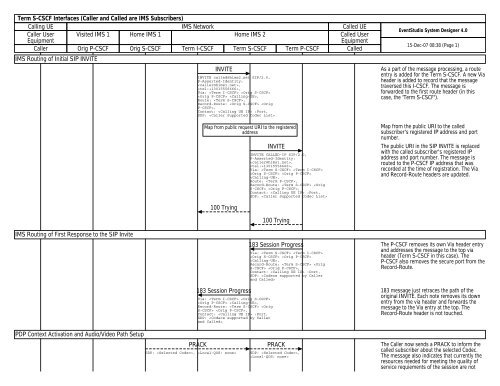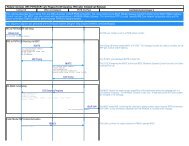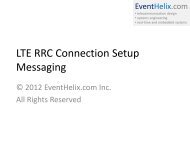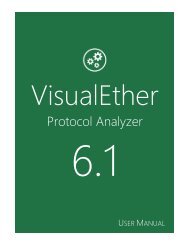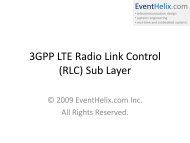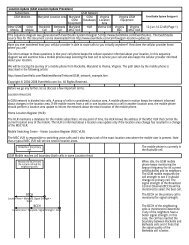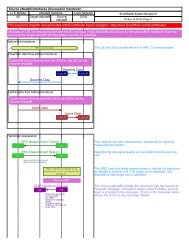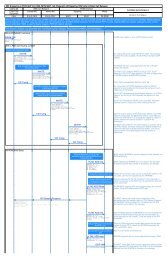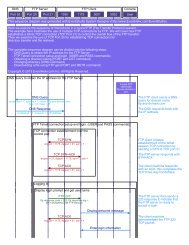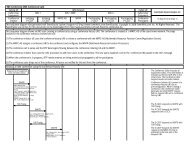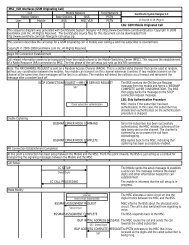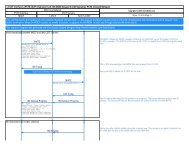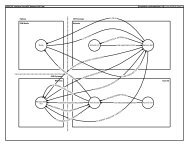Terminating S-CSCF Role Sequence Diagram - EventHelix.com
Terminating S-CSCF Role Sequence Diagram - EventHelix.com
Terminating S-CSCF Role Sequence Diagram - EventHelix.com
You also want an ePaper? Increase the reach of your titles
YUMPU automatically turns print PDFs into web optimized ePapers that Google loves.
Term S-<strong>CSCF</strong> Interfaces (Caller and Called are IMS Subscribers)<br />
Calling UE IMS Network Called UE<br />
Caller User<br />
Equipment<br />
Visited IMS 1 Home IMS 1 Home IMS 2 Called User<br />
Equipment<br />
Caller Orig P-<strong>CSCF</strong> Orig S-<strong>CSCF</strong> Term I-<strong>CSCF</strong> Term S-<strong>CSCF</strong> Term P-<strong>CSCF</strong> Called<br />
IMS Routing of Initial SIP INVITE<br />
INVITE<br />
INVITE called@hims2.net SIP/2.0,<br />
P-Asserted-Identity:<br />
,<br />
,<br />
Via: <br />
,<br />
Route: ,<br />
Record-Route: ,<br />
Contact: :Port,<br />
SDP: <br />
Map from public request URI to the registered<br />
address<br />
INVITE<br />
INVITE CALLED-IP SIP/2.0,<br />
P-Asserted-Identity:<br />
,<br />
,<br />
Via: <br />
<br />
,<br />
Route: ,<br />
Record-Route: ,<br />
Contact: :Port,<br />
SDP: <br />
EventStudio System Designer 4.0<br />
15-Dec-07 08:38 (Page 1)<br />
As a part of the message processing, a route<br />
entry is added for the Term S-<strong>CSCF</strong>. A new Via<br />
header is added to record that the message<br />
traversed this I-<strong>CSCF</strong>. The message is<br />
forwarded to the first route header (in this<br />
case, the "Term S-<strong>CSCF</strong>").<br />
Map from the public URI to the called<br />
subscriber's registered IP address and port<br />
number.<br />
The public URI in the SIP INVITE is replaced<br />
with the called subscriber's registered IP<br />
address and port number. The message is<br />
routed to the P-<strong>CSCF</strong> IP address that was<br />
recorded at the time of registration. The Via<br />
and Record-Route headers are updated.<br />
100 Trying<br />
IMS Routing of First Response to the SIP Invite<br />
183 Session Progress<br />
Via: <br />
,<br />
Record-Route: ,<br />
Contact: :Port,<br />
SDP: <br />
100 Trying<br />
183 Session Progress<br />
Via: <br />
<br />
,<br />
Record-Route: ,<br />
Contact: :Port,<br />
SDP: <br />
The P-<strong>CSCF</strong> removes its own Via header entry<br />
and addresses the message to the top via<br />
header (Term S-<strong>CSCF</strong> in this case). The<br />
P-<strong>CSCF</strong> also removes the secure port from the<br />
Record-Route.<br />
183 message just retraces the path of the<br />
original INVITE. Each note removes its down<br />
entry from the via header and forwards the<br />
message to the Via entry at the top. The<br />
Record-Route header is not touched.<br />
PDP Context Activation and Audio/Video Path Setup<br />
PRACK<br />
SDP: , <br />
PRACK<br />
SDP: ,<br />
<br />
The Caller now sends a PRACK to inform the<br />
called subscriber about the selected Codec.<br />
The message also indicates that currently the<br />
resources needed for meeting the quality of<br />
service requiements of the session are not
Term S-<strong>CSCF</strong> Interfaces (Caller and Called are IMS Subscribers)<br />
Calling UE IMS Network Called UE<br />
Caller User<br />
Equipment<br />
Visited IMS 1 Home IMS 1 Home IMS 2 Called User<br />
Equipment<br />
Caller Orig P-<strong>CSCF</strong> Orig S-<strong>CSCF</strong> Term I-<strong>CSCF</strong> Term S-<strong>CSCF</strong> Term P-<strong>CSCF</strong> Called<br />
200 OK<br />
SDP: , <br />
UPDATE<br />
SDP: <br />
SDP: <br />
200 OK<br />
SDP: ,<br />
<br />
UPDATE<br />
SDP: <br />
available.<br />
EventStudio System Designer 4.0<br />
15-Dec-07 08:38 (Page 2)<br />
The called subscriber acknowledges the<br />
PRACK. The message also indicates that<br />
quality of service for the session is not met for<br />
the called subscriber.<br />
Since the caller PDP context has been<br />
activated, notify the called end that the caller<br />
can now meet the quality of service in the<br />
send and receive direction.<br />
200 OK<br />
200 OK<br />
The caller replies back to the called user. Note<br />
that the Local QoS is still set to none as the<br />
SDP: <br />
called PDP context activation has not been<br />
<strong>com</strong>pleted.<br />
180 Ringing 180 Ringing<br />
Inform the caller that the called subscriber is<br />
being rung. This serves as an implicit<br />
indication to the caller that the QoS at the<br />
called side has also been met.<br />
PRACK PRACK The caller acknowledges the ringing message.<br />
200 OK 200 OK<br />
The called subscriber acknowledges the<br />
PRACK.<br />
200 OK 200 OK<br />
Notify the caller that that the call has been<br />
answered.<br />
ACK ACK The caller acknowledges the "200 OK"<br />
message. The call is now ready to enter<br />
conversation mode.


